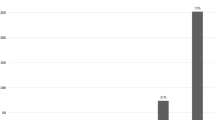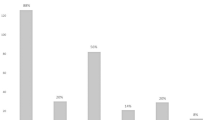Abstract
Background
Gastroesophageal reflux disease (GERD) is a common chronic disorder of the gastrointestinal tract, affecting more than 50% of Americans. The development of GERD may be associated with ineffective esophageal motility (IEM). The impact of esophageal motility on outcomes post laparoscopic antireflux surgery (LARS), including quality of life (QOL), remains to be defined. The purpose of this study is to analyze and compare QOL outcomes following LARS among patients with and without ineffective esophageal motility (IEM).
Methods
This is a single-institution, retrospective review of a prospectively maintained database of patients who underwent LARS, from January 2012 to July 2019, for treatment of GERD at our institution. Patients undergoing revisional surgery were excluded. Patients with normal peristalsis (non-IEM) were distinguished from those with IEM, defined using the Chicago classification, on manometric studies. Four validated QOL surveys were used to assess outcomes: Reflux Symptom Index (RSI), Gastroesophageal Reflux Disease Health-Related QOL (GERD-HRQL), Laryngopharyngeal Reflux Health-Related QOL (LPR-HRQL), and Swallowing Disorders (SWAL) survey.
Results
203 patients with complete manometric data were identified (75.4% female) and divided into two groups, IEM (n = 44) and non-IEM (n = 159). IEM and Non-IEM groups were parallel in age (58.1 ± 15.3 vs. 62.2 ± 12 years, p = 0.062), body mass index (27.4 ± 4.1 vs. 28.2 ± 4.9 kg/m2, p = 0.288), distribution of comorbid disease, sex, and ASA scores. The groups differed in manometry findings and Johnson–DeMeester score (IEM: 38.6 vs. Non-IEM: 24.0, p = 0.023). Patients in both groups underwent similar rates of Nissen fundoplication (IEM: 84.1% vs. Non-IEM: 93.7%, p = 0.061) with greater improvements in dysphagia (IEM: 27.4% vs. 44.2%) in Non-IEM group but comparable benefit in reflux reduction (IEM: 80.6% vs. 72.4%) in both groups at follow-up. There were no differences in postoperative outcomes. Satisfaction rates with LARS were similar between groups (IEM: 80% vs. non-IEM: 77.9%, p > 0.05).
Conclusion
Patients with ineffective esophageal motility derive significant benefits in perioperative and QOL outcomes after LARS. Nevertheless, as anticipated, their baseline dysmotility may reduce the degree of improvement in dysphagia rates post-surgery compared to patients with normal motility. Furthermore, the presence of preoperative IEM should not be a contraindication for complete fundoplication. Key to optimal outcomes after LARS is careful patient selection based on objective perioperative data, including manometry evaluation, with the purpose of tailoring surgery to provide effective reflux control and improved esophageal clearance.


Similar content being viewed by others
References
Stefanidis D, Hope WW, Kohn GP, Reardon PR, Richardson WS, Fanelli RD (2010) Guidelines for surgical treatment of gastroesophageal reflux disease. Surg Endosc. https://doi.org/10.1007/s00464-010-1267-8
Peery AF, Crockett SD, Barritt AS et al (2015) Burden of gastrointestinal, liver, and pancreatic diseases in the United States. Gastroenterology 149(7):1731–1741.e3. https://doi.org/10.1053/j.gastro.2015.08.045
Liu L, Li S, Zhu K et al (2019) Relationship between esophageal motility and severity of gastroesophageal reflux disease according to the Los Angeles classification. Medicine (Baltimore) 98(19):e15543. https://doi.org/10.1097/MD.0000000000015543
Kahrilas PJ, Bredenoord AJ, Fox M et al (2015) The Chicago classification of esophageal motility disorders, v30. Neurogastroenterol Motil. https://doi.org/10.1111/nmo.12477
Leite LP, Johnston BT, Barrett J, Castell JA, Castell DO (1997) Ineffective esophageal motility (IEM): the primary finding in patients with nonspecific esophageal motility disorder. Dig Dis Sci. https://doi.org/10.1023/A:1018802908358
Chugh P, Collazo T, Dworkin B, Jodorkovsky D (2019) Ineffective esophageal motility is associated with impaired bolus clearance but does not correlate with severity of dysphagia. Dig Dis Sci 64(3):811–814. https://doi.org/10.1007/s10620-018-5384-x
Wirsching A, Zhang Q, McCormick SE, Hubka M, Low DE (2018) Abnormal high-resolution manometry findings and outcomes after paraesophageal hernia repair. J Am Coll Surg 227(2):181–188.e2. https://doi.org/10.1016/j.jamcollsurg.2018.03.033
Fuchs HF, Gutschow CA, Brinkmann S et al (2014) Effect of laparoscopic antireflux surgery on esophageal motility. Dig Surg 31(4–5):354–358. https://doi.org/10.1159/000368662
Addo A, Broda A, Reza Zahiri H, Brooks IM, Park A (2019) Resolution of anemia and improved quality of life following laparoscopic hiatal hernia repair. Surg Endosc. https://doi.org/10.1007/s00464-019-07054-9
Park A, Weltz AS, Sanford Z, Addo A, Zahiri HR (2019) Laparoscopic antireflux surgery (LARS) is highly effective in the treatment of select patients with chronic cough. Surgery (US). https://doi.org/10.1016/j.surg.2019.01.036
Sanford Z, Jayaraman S, Weltz AS, Reza Zahiri H, Park A (2020) The role of body mass index in determining clinical and quality of life outcomes after laparoscopic anti-reflux surgery. Surgery Endosc. https://doi.org/10.1007/s00464-019-06811-0
Lu R, Addo A, Broda A et al (2020) Update on the durability and performance of collis gastroplasty for chronic GERD and hiatal hernia repair at 4-year post-intervention. J Gastrointest Surg. https://doi.org/10.1007/s11605-019-04438-z
Weltz AS, Zahiri HR, Sibia US, Wu N, Fantry GT, Park AE (2017) Patients are well served by Collis gastroplasty when indicated. Surgery (US). https://doi.org/10.1016/j.surg.2017.04.005
Ravi N, Al-Sarraf N, Moran T et al (2005) Acid normalization and improved esophageal motility after Nissen fundoplication: equivalent outcomes in patients with normal and ineffective esophageal motility. Am J Surg. https://doi.org/10.1016/j.amjsurg.2005.05.040
Baigrie RJ, Watson DI, Myers JC, Jamieson GG (1997) Outcome of laparoscopic Nissen fundoplication in patients with disordered preoperative peristalsis. Gut. https://doi.org/10.1136/gut.40.3.381
Novitsky YW, Wong J, Kercher KW, Litwin DEM, Swanstrom LL, Heniford BT (2007) Severely disordered esophageal peristalsis is not a contraindication to laparoscopic Nissen fundoplication. Surg Endosc Other Interv Tech. https://doi.org/10.1007/s00464-006-9126-3
Park AE, Hoogerboord CM, Sutton E (2012) Use of the falciform ligament flap for closure of the esophageal hiatus in giant paraesophageal hernia. J Gastrointest Surg. https://doi.org/10.1007/s11605-012-1888-4
Belafsky PC, Postma GN, Koufman JA (2002) Validity and reliability of the reflux symptom index (RSI). J Voice. https://doi.org/10.1016/S0892-1997(02)00097-8
Velanovich V (2007) The development of the GERD-HRQL symptom severity instrument. Dis Esophagus. https://doi.org/10.1111/j.1442-2050.2007.00658.x
Carrau RL, Khidr A, Gold KF et al (2005) Validation of a quality-of-life instrument for laryngopharyngeal reflux. Arch Otolaryngol. https://doi.org/10.1001/archotol.131.4.315
McHorney CA, Robbins JA, Lomax K et al (2002) The SWAL-QOL and SWAL-CARE outcomes tool for oropharyngeal dysphagia in adults: III. Documentation of reliability and validity. Dysphagia. https://doi.org/10.1007/s00455-001-0109-1
Harris PA, Taylor R, Thielke R, Payne J, Gonzalez N, Conde JG (2009) Research electronic data capture (REDCap): a metadata-driven methodology and workflow process for providing translational research informatics support. J Biomed Inform. https://doi.org/10.1016/j.jbi.2008.08.010
Bakhos CT, Petrov RV, Parkman HP, Malik Z, Abbas AE (2019) Role and safety of fundoplication in esophageal disease and dysmotility syndromes. J Thorac Dis 11(4):S1610–S1617. https://doi.org/10.21037/jtd.2019.06.62
Nikolic M, Schwameis K, Kristo I et al (2020) Ineffective esophageal motility in patients with GERD is no contraindication for Nissen fundoplication. World J Surg 44(1):186–193. https://doi.org/10.1007/s00268-019-05229-y
Freys SM, Fuchs KH, Heimbucher J, Thiede A (1997) Tailored augmentation of the lower esophageal sphincter in experimental antireflux operations. Surg Endosc. https://doi.org/10.1007/s004649900565
Thor KBA, Silander T (1989) A long-term randomized prospective trial of the Nissen procedure versus a modified Toupet technique. Ann Surg. https://doi.org/10.1097/00000658-198912000-00005
Gyawali CP, Sifrim D, Carlson DA et al (2018) Ineffective esophageal motility: concepts, future directions, and conclusions from the Stanford 2018 symposium. Neurogastroenterol Motil 2019: https://doi.org/10.1111/nmo.13584
Smith CD, Devault KR, Buchanan M (2014) Introduction of mechanical sphincter augmentation for gastroesophageal reflux disease into practice: early clinical outcomes and keys to successful adoption. J Am Coll Surg. https://doi.org/10.1016/j.jamcollsurg.2013.12.034
Asti E, Bonitta G, Lovece A, Lazzari V, Bonavina L (2016) Longitudinal comparison of quality of life in patients undergoing laparoscopic Toupet fundoplication versus magnetic sphincter augmentation: observational cohort study with propensity score analysis. Medicine (US). https://doi.org/10.1097/MD.0000000000004366
Munitiz V, Ortiz A, Martinez De Haro LF, Molina J, Parrilla P (2004) Ineffective oesophageal motility does not affect the clinical outcome of open Nissen fundoplication. Br J Surg. https://doi.org/10.1002/bjs.4597
Simić AP, Skrobić OM, Gurski RR, Šljukić VM, Ivanović NR, Peško PM (2014) Can different subsets of ineffective esophageal motility influence the outcome of Nissen fundoplication? J Gastrointest Surg. https://doi.org/10.1007/s11605-014-2607-0
Booth MI, Stratford J, Jones L, Dehn TCB (2008) Randomized clinical trial of laparoscopic total (Nissen) versus posterior partial (Toupet) fundoplication for gastro-oesophageal reflux disease based on preoperative oesophageal manometry. Br J Surg. https://doi.org/10.1002/bjs.6047
Mello MD, Shriver AR, Li Y, Patel A, Gyawali CP (2016) Ineffective esophageal motility phenotypes following fundoplication in gastroesophageal reflux disease. Neurogastroenterol Motil. https://doi.org/10.1111/nmo.12728
Broeders JA, Sportel IG, Jamieson GG et al (2011) Impact of ineffective oesophageal motility and wrap type on dysphagia after laparoscopic fundoplication. Br J Surg 98(10):1414–1421. https://doi.org/10.1002/bjs.7573
Hajibandeh S, Hajibandeh S, Pugh M, Winters D, Hobbs N, Tarazi M, Panda N, Dalmia S, Mansour M, Malik S (2018) Impact of Toupet versus Nissen fundoplication on dysphagia in patients with gastroesophageal reflux disease and associated preoperative esophageal dysmotility: a systematic review and meta-analysis. Surg Innov. https://doi.org/10.1177/1553350618799549
Patti MG, Robinson T, Galvani C et al (2004) Total fundoplication is superior to partial fundoplication even when esophageal peristalsis is weak. J Am Coll Surg. https://doi.org/10.1016/j.jamcollsurg.2004.01.029
Zornig C, Strate U, Fibbe C, Emmermann A, Layer P (2002) Nissen vs Toupet laparoscopic fundoplication: a prospective randomized study of 200 patients with and without preoperative esophageal motility disorders. Surg Endosc Other Interv Tech. https://doi.org/10.1007/s00464-001-9092-8
Funding
No financial support was received for this study.
Author information
Authors and Affiliations
Contributions
All authors certify that they accept responsibility as an author and have contributed to the concept, data gathering, analysis, manuscript drafting, and give their final approval.
Corresponding author
Ethics declarations
Disclosures
Dr. Park reports grants and personal fees from Stryker, outside the submitted work; Dr. Addo, George, and Zahiri have no conflict of interest or financial or relevant financial ties to disclose
Additional information
Publisher's Note
Springer Nature remains neutral with regard to jurisdictional claims in published maps and institutional affiliations.
Rights and permissions
About this article
Cite this article
Addo, A., George, P., Zahiri, H.R. et al. Patients with ineffective esophageal motility benefit from laparoscopic antireflux surgery. Surg Endosc 35, 4459–4468 (2021). https://doi.org/10.1007/s00464-020-07951-4
Received:
Accepted:
Published:
Issue Date:
DOI: https://doi.org/10.1007/s00464-020-07951-4




